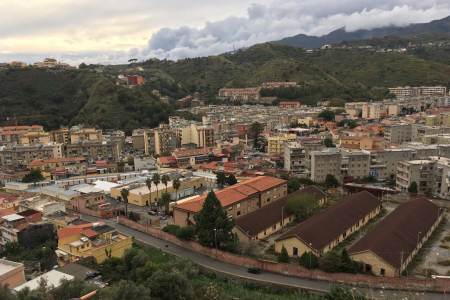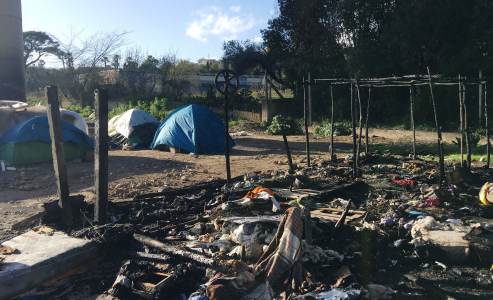A young asylum seeker dies after being run over on the highway of Pian del Lago
The young men run over on the highway of the hamlet Pian del Lago last April 10 (Il Fatto Nisseno), did not survive. He died last April 20, on the intensive care unit at the hospital of Saint Elia of Caltanissetta. We were able to obtain this news through informal channels only 10 days later. No official institution spread the news. Neither the police department nor the prefecture communicated the death of an asylum seeker who died because of a run over on the highway that connects the government reception centre and the immigration office of the police department with the urban centre of Caltanissetta.
A dangerous road, without sidewalk and lights, on which already other people had been run over, all asylum seekers hosted at the centre.
Muhammad was 29 years old and originally from Pakistan. He had been in Caltanissetta for a few months and presented his official asylum request already at his arrival at the Caltanissettan police department. Waiting for an accommodation, he lived in a tumbledown property near the CARA*, thus to be able to be in front of the gates all three days of the week in which the admissions of those on the waiting list were handled.
Last April 10, he was run over by a car while walking along that damned road. Some silent days followed, during which the severity of his health conditions were not clear, until we heard the news through some of his fellow countrymen who organized a remembrance ceremony in his honour before the repatriation of the coffin to his country.
In this silence and the absence of any institution, his friends and fellows organized a ceremony for the last farewell to Muhammad – and this happened in the car park in front of the stadium.
No institution was present, no words of grief came to the mind of his friends, no representative of the centre participated at the commemoration which took place about 30 metres from the entrance gates, where Muhammad went for several weeks trying to get an accommodation.
Many people were at the commemoration, not only from Pakistan. As it is written in the press release of “Sportello Immigrati”: “there were many Africans and Afghans. The whole world was there. Only Italy was absent”.
Also those who didn’t know Muhammad directly participated at this simple and sincere ceremony, because of a common sense of humanity which, though, doesn’t seem to be so taken for granted. There was strong empathy from many of the present who live at the centre or in nearby abandoned houses – also because of the awareness of the danger into which they run daily by transiting on that unsafe road which they have to walk along in order to get into town.
The only Italian citizens participating to the sorrow and injustice of this death caused by the danger of the road were the representatives of “Sportello Immigrati” and a freelance journalist.
Some journalists, but not a single institution, arrived during the commemoration, which lasted several hours because they had to first wait for a long time for the body to arrive.
In the sadness for this death accompanied by the disconcerting loneliness and institutional silence, there is room only for some bitter questions.
This time there are no traffickers to blame and no military mission to invoke as accomplice for the death of migrants who try to reach fortress Europe in a way that outflanks the real responsibilities of Italian and European migration policies. So how do we value the responsibility of what happens to asylum seekers forced to live at the margins of society, outside a guaranteed minimum of fundamental rights contained in our constitution and in communitarian conventions and universal declarations?
May the local institutions, the government’s local offices or those associations that handle official centres be considered responsible, considering the inacceptable isolation of the reception centre and of the immigration office that are separated from the urban centre by a dangerous 5km long road lacking any transport service, lighting and sidewalks?
If the answer to this question appears trivial, the arising question is the following: when will the named institution take the necessary measures in order to guarantee the safety of hundreds of persons who are forced to walk along that road on a daily basis?
And again, in front of this foretold (and thus preventable) death, which is the responsibility of the Ministry of Interior Affairs that places reception centres for hundreds of asylum seekers at the margins of a city with no public transport connection? And which is the responsibility of the police department who moved there its immigration office, hence forcing anyone who needs to go there (obviously foreigners) to make such a dangerous journey?
Who is responsible for the now accepted practice of forcing asylum seekers to sleep in badly arranged places for weeks before getting an accommodation within a system that has been operating though emergency measures for the last 25 years?
And furthermore, what responsibility has the prefecture by not including (and thus imposing) into the contract for the management of reception centres the institution of a bus shuttle for the guests, considering the three-year contract of 18.000.000€?
Which is the responsibility of the association managing the reception centre that does not ensure its guests the possibility to leave the spatial and social isolation in which it is situated?
And in turn, what responsibility has the town administration for leaving a road that is used by hundreds of persons every day without lighting nor a sidewalk, and for not providing a coverage with public transportation? Besides, it concerns an area with sport facilities used by many citizens who, though, are able to reach it only by private means of transport.
The reflections arising from these questions and the void left by the actions of the institutions lead to another question: given that reception policies always show their inadequacy in relation to human rights (and consequently delegitimizing their own existence); and given that the government’s centre of Pian del Lago has been active since 1998, in all these years how were the institutions committed in guaranteeing at least the safety of the hundreds of persons living at the reception centre and why wasn’t any official representative present last Thursday?
What would have happened, if the serious structural lack of that road and the absence of a public transport system in an area inhabited by hundreds of people had caused the death of an Italian citizen? Which would have been the role of institutional representatives in front of such a tragedy? Which would have been the words used for this unjust death? What role would have had the press, the local associations and the town?
And among all this question, one always reappears: how is it possible, after decades, that immigration policies and their (deriving) reception practices continue to perpetuate the creation of class A and class B citizens, notwithstanding the fact that the constitution guarantees to all men fundamental rights and equal social dignity, thus calling the institution to remove any economic or social obstacle which, by limiting equality, impedes the full development of a human person?
These fundamental principles of our system are all too often not applied when it comes to protecting the most vulnerable categories, including asylum seekers.
Giovanna Vaccaro
Borderline Sicilia Onlus
Translation: Chiara Guccione
*CARA – Centro di accoglienza per richiedenti asilo: Hosting centre for asylum seekers


